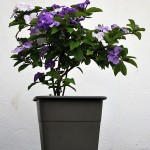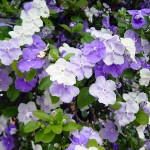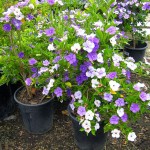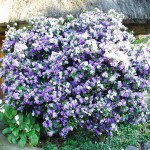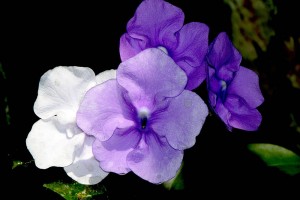Family: Solanaceae
Synonymous: Brunfelsia calycina (basionym)
Brunfelsia pauciflora var. calycina
Franciscea pauciflora (basionym)
Distributiona and habitat: Brunfelsia pauciflora is a species of flowering semi-deciduous shrub, endemic to Brazil, growing in light woodland and thickets. This shrub is growing up to 3m (10 feet) with a 3.6m (12 feet) spread. It is cultivated for its fragrant flowers. The species name, bonodora, is from the Latin, and means 'sweet-smelling'.
Description: Poted Brunfelsia pauciflora are small shrubs, up to 60cm (24 inch) high with a 30cm (12 inch) spread, that have 8-15cm (3-6 inch) long lance-shaped, glossy, yet leathery leaves and showy, often fragrant, flowers. Its common name, Yesterday-Today-and-Tomorrow, comes from the way its flowers are changing in colour form one day to the next. Each bloom opens violet-purple, fade to pale lavender-blue, becomes almost white and is dead by the fourth day. Flat, five-lobed flowers are up to 5cm (2 inch) across, with a small, white, puckered eye - the entry point for insects to a short tube behind the floral surface. Flowers appear in clusters of up to 10 on the end of long stems, but open singly. Under favourable conditions, Brunfelsia pauciflora can bloom throughout the year.
Houseplant care: Brunfelsia pauciflora is the only one species fromBrunfelsia genus grown indoors. Prune old plants drastically in spring or just at the end of the rest period if they have one. When pruning take out as much as half the previous year's growth. To encourage more vigorous bushy growth, pinch out the growing tips - this can be done any time.
Light: Bright light, including three or four of direct sunlight daily, is essential throughout the year for satisfactory flowering.
Temperature: During the active growth period normal room temperature is suitable. Stand pots on trays of damp pebbles for increased humidity. Where warm, humid condition are provided in winter, these plants will not have an appreciable rest period, but they will not suffer as a result. If such condition are not provided, move Brunfelsia pauciflora to a really cold possition - ideally between 10C (50F) and 13C(55F) - so they can have at least a four to six weeks rest.
Watering: In the active growth period water moderately, enough to make the potting mixture thoroughly moist, but allow the top 1cm (0.4 inch) of the potting mixture to dry out between waterings. If plants are given a rest, water them only enough during the rest period to keep the potting mixture from drying out completely.
Feeding: Give actively growing plants an application of standard liquid fertiliser every two weeks to promote vigorous growth.
Poting and repotting: Use a soil based potting mixture. Brunfelsia pauciflora flower best when their roots are confined in small pots - 13-15cm (5-6 inch) at most. Repot in fresh potting mixture every spring, but do not increase pot size. Simply replace the old mixture with new.
Gardening: Brunfelsia pauciflora are long-lived, romantic flowering shrubs. Warm subtropical gardens are ideal, but the plants will also flourish in colder climates. They will even endure light frost, but will be deciduous during the cooler months. Outside of its hardiness zone, growBrunfelsia pauciflora in a pot so it can be moved indoors when temperatures drop.
They are quick and easy to grow. No pruning is needed for garden plants except to control growth and spreading. A light trim after flowering will help keep it tidy yet bushy.
Position: Brunfelsia pauciflora do best in full sun but needs some shady protection during the heat of the day to look their best. Also do well in filtered shade.
Soil: Provide rich, moist, but well drained soil with liberal quantities of compost worked into it. Brunfelsia pauciflora prefer acidic soil with a pH balance just below the neutral 7, so mulch with pine-needles, moss or acidic compost around their bases.
Irrigation: Keep the soil moist around the Brunfelsia pauciflora , but not overly wet. Do not allow the soil to dry out. If rain is not imminent, water the soil, especially during the hot summer days.
Container plants should be checked daily for moistness. Reduce watering plants in containers in fall.
Fertiliser: Fertilise plants with 10-10-10 (nitrogen-phosphate-potassium) water-soluble fertiliser, using full strength for garden plants once a month and diluted in half for container plants every two weeks. Only fertilise the plant during spring and summer months.
Propagation: Propagate Brunfelsia pauciflora in spring when tip cuttings of new growth are available. Dip cutting 8-13cm (3-5 inch) long in hormone rooting powder and plant it in an 8cm (3 inch) pot containing a moistened equal-parts mixture of peat moss and coarse sand or perlite. Place the cutting in a plastic bag or propagating case and stand it in bright filtered light. When new growth is produced (in four to six weeks), uncover the young plant, begin moderate watering and apply standard liquid fertiliser every two weeks. About four months after the start of propagation, move the new Brunfelsia pauciflora plants into standard potting mixture and treat it as a mature plant.
Problems:
Pale or yellow leaves result from potting mixture that is not acid enough.
Treatment: Repot the plant in potting mixture that contains some peat and add some iron sulphate to the water when watering. Another way of ensuring healthy deep-green foliage is to sprinkle a handful of nitrogenrich fertilizer granules around the root zones and to water it in immediately thereafter. Do not overdo this treatment at the expense of potassium-rich fertilizer, though, otherwise the plant will have gorgeous foliage but the production of flowers will be diminished.
Weak growth is a sign of aphids, which suck the sap of the plant.
Treatment: Wash them off with a gentle stream of tepid water.
Fine webbing at leaf axils and under the leaves is made by the red spider mite, which thrives in dry conditions.
Treatment: Raise the humidity around the plant by mist spraying and standing the pot on a tray of moist pebbles. Serious infestations should be treated with a suitable insecticide.
Mealy bugs and whitefly may infest the Brunfelsia pauciflora plants.
Treatment: Apply sprays of suitable insecticides.
Can get thrips when plants are grown under glass.
Treatment: Although thrips are susceptible to insecticides, their control is difficult as they are capable of flight and they may hide inside the buds and other floral structures and out of the reach of the insecticides. Hence, multiple sprayings may be needed with severe infestation.
Recommended varieties:
Brunfelsia pauciflora cv. 'Floribunda' is a profusely flowering miniature kind.
Brunfelsia pauciflora cv. 'Macrantha' has flowers measuring up to 8cm (3 inch) across.
Companion plants: Brunfelsia pauciflora makes a good companion to Rhododendron (Azaleas) and Fuchsia species (Fuchsias). Grow it with Cineraria (Cinerarias) or Muscari species (Grape hyacinths) placed at its feet to enhance the colour of its blooms. Canna, Tibouchina, Lantana speacies are good companions for these colourful shrubs, highlighting each other.
Toxicity: Brunfelsia pauciflora plant is toxic, especially the fruit. The plants are known to be poisonous to domestic animals such as cats, dogs and horses due to their brunfelsamidine content.
Also caution should be taken due to its strongly scented flowers, reason for which Brunfelsia pauciflora is not the ideal plant for hay-fever sufferers.
Usage and display: With pruning,Brunfelsia pauciflora can be kept to a manageable 60-90cm (2-3 feet) size and makes an excellent indoor plant. In mild climates,Brunfelsia pauciflora makes an attractive specimen shrub or use it in a mixed hedge or foundation planting. Can be used for creating perfumed spots in gardens, designing tropical gardens and hedge or screen seaside gardens or as a specimen plant. It is great for privacy screening on decks or blocking unsightly views.
SUMMARY:
CHARACTERISTICS:
Foliage green
Features flowers, frangrance
Shape bushy
Height indoors: 60-90cm (24-36 inch)
Height outdoors: 3m (10 feet)
Spread outdoors: 3.6m (12 feet)
PROPER CARE:
Watering in rest period sparingly
Watering in active growth period moderately
Light bright
Temperature in rest period min 10C max 13C (50-55F)
Temperature in active growth period min 16C max 24C (61-75F)
Humidity high
Hardiness zone: 9-11
